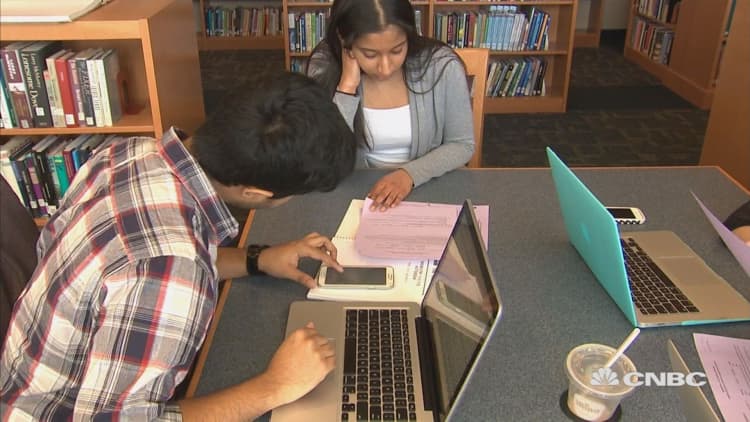It's no secret that attending a community college can be a stepping stone toward obtaining a bachelor's degree. However, few of these students actually get there within four years.
Just 16 percent of students who began their education at a community college in 2010 successfully wrapped up their degree at a four-year school by spring 2016, according to data from the National Student Clearinghouse Research Center.
In comparison, 62.4 percent of students who started at a four-year public university completed their degree within six years. That completion rate ticked up to nearly 74 percent for those who started at four-year private schools, the center found.

"People think it's straightforward: Two years at one school and two years at the other," said Doug Shapiro, executive research director of the National Student Clearinghouse.
"On average, it takes five years to do it, and that's because so many people go to school part time; they go into the workforce and care for family," he said.
It won't be easy, but here's how your student can make the climb from a two-year community college to successful completion of a bachelor's degree at a four-year school.
The true cost of savings
Generally, you can count on tuition being lower at a community college compared with a four-year school, which could help curb large amounts of student loan debt. See below.
In reality, however, the transfer process isn't as smooth as students expect.
Aside from running into personal obstacles at home, including managing demands related to work and family, students have difficulty getting their completed credits recognized at the four-year school.
"The typical number of credits is 60 for an associate's degree and you need 60 more for a bachelor's," said Josh Wyner, vice president of the Aspen Institute and a co-author of The Transfer Playbook, a research paper on best practices for two- and four-year colleges.
"If they transfer and the school tells them they need even more credits to complete a bachelor's in neuroscience or in marketing, it could mean five years of education and not four," he said.
Longer completion times can also affect your eligibility to receive financial aid.
Administrative hurdles
Other hurdles are administrative: Students who wish to transfer to the four-year school have to apply and gain acceptance there.
To help simplify that process, a number of schools have established programs to streamline the migration from a community college. Some guarantee admission into the bachelor's degree program, provided the student meets certain requirements.
For instance, DirectConnect to University of Central Florida is a program that eases the transition from Valencia College, a two-year school, to a bachelor's degree program. Those who complete an associate's degree from a partner school receive guaranteed admission to UCF, plus assistance with financial aid and enrollment.
People think it's straightforward: Two years at one school and two years at the other. On average, it takes five years to do it.Doug Shapiroexecutive director of the National Student Clearinghouse Research Center
The Commonwealth Commitment program in Massachusetts calls for students to complete their associate's degree within 2½ years, transfer to a state university to wrap up their bachelor's within two more years and maintain full-time enrollment and a 3.0 GPA.
In exchange, the state will freeze tuition and mandatory fees, as well as guarantee admission and transfer of credits.
"It's very important to have a path from enrollment through completion, to plan out what you'll do when and to focus on courses that you know will transfer," said Mark Kantrowitz, vice president of strategy for college and scholarship search site Cappex.com.
More from College Game Plan:
Here's what to do about your student debt
The cost of borrowing is going up
Community college may be the secret sauce in affordable education
Making a successful leap
Students who want to migrate from a community college to a four-year school should be choosy about where they attend. Here's what to look for in both institutions, according to Wyner.
- Transfer students must be a priority: When selecting your two-year school, ask how many students transfer and how many of their credits will apply to a four-year degree. Here's another question: Does your four-year dream school have staff that's committed to assisting transfer students?
- Find two- and four-year schools with a program map: If you've put in two years at a community college, make sure that you land at your four-year school as a junior. Ask your four-year dream school if they can perform an audit of your transcript to ensure that your credits will transfer.
- Seek dedicated advising for transfers at both schools: You'll need guidance on how much you'll require in financial aid, given your lower costs for the first two years. You should also identify your major as early as you can and ensure your courses work toward your prerequisites.
"High-performing institutions often treat the two-year student the way they treat a rising junior who's been there since freshman year," Wyner said. "That's an important issue."




